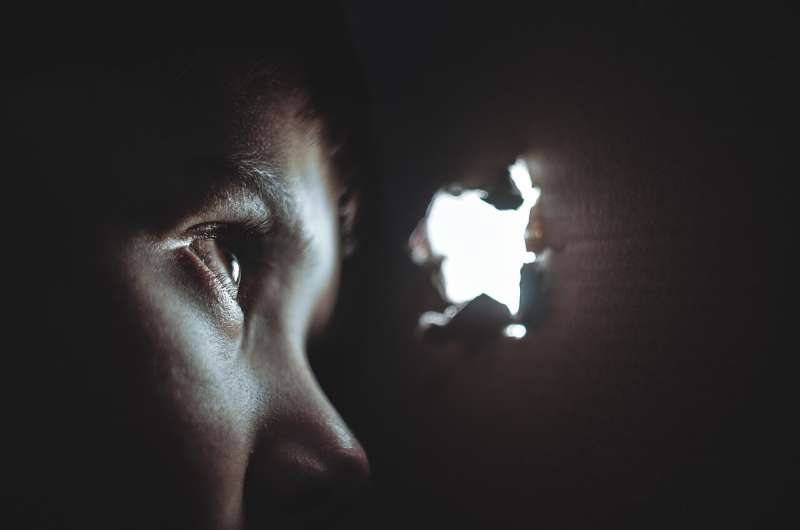This article has been reviewed according to Science X's editorial process and policies. Editors have highlighted the following attributes while ensuring the content's credibility:
fact-checked
trusted source
proofread
Study finds disparate gender differences in victims of child sex trafficking

In the United States, federal laws were created to effectively decriminalize prostitution in minors under the age of 18. However, state and local justice systems continue to arrest and incarcerate minors for prostitution, despite widespread agreement that youth involved in commercial sexual exploitation are victims, not offenders.
Most youth tend to fall victim to child prostitution and sex trafficking between the ages of 12 and 14. Victims of child prostitution have especially high rates of prior physical, sexual and emotional abuse as well as neglect.
Calli M. Cain, Ph.D., an assistant professor at Florida Atlantic University's College of Social Work and Criminal Justice, examined the characteristics and risk factors such as victimization histories, living situations and drug/alcohol use, of incarcerated youth charged with prostitution in the U.S. Given that males and females have different pathways to crime/arrest, she also tested for gender differences in these risk factors.
The study, published in the journal Victims & Offenders, is the first to look at gender differences in a nationally representative sample of detained youth. Results show that this population of incarcerated youth has several risk factors, including extensive victimization experiences during childhood, and that these experiences vary by gender.
The sample included 2,643 incarcerated youth involved in prostitution, which was defined as "being paid for having sexual relations with someone."
Among the key findings of the study:
- Seventy-five percent were males and 25 percent were females. The most commonly incarcerated youth were white males (29.4 percent), about 16 years old, followed by black (26.8 percent) and Hispanic (24.7 percent) males.
- About 30 percent of the female sample were white, followed by two or more races/other (24.6 percent), black (23.7 percent) and lastly Hispanic (21.6 percent).
- Nearly 43 percent indicated they had been molested as a child and more than 35 percent had experienced forced sex growing up.
- Nearly half (45.9 percent) indicated they had experienced emotional abuse; the majority (85.3 percent) also indicated they had witnessed serious violence.
"Most youth charged with prostitution have an extensive history of victimization experiences and detaining them often exacerbates their problems, delays appropriate care, interrupts their education, exposes them to youth who commit more serious offenses, and increases justice system costs," said Cain.
The study showed that female youth charged with prostitution had significantly higher prevalence rates of every form of victimization except witnessing serious violence. Nearly four out of five females reported experiencing physical abuse as a child compared to just over half of males.
- Almost two-thirds of the girls were molested as a child, half were raped, and three-fourths were emotionally abused as a child, compared to 36 percent of males who were molested, 31 percent who were raped, and 37 percent who were emotionally abused.
- Significantly more females (84 percent) reported using substances every day or several times a week in the months before custody compared to 75 percent of males.
- Females had far higher rates of polyvictimization; 80 percent reported three or more victimization types compared to males (49 percent), and 31 percent of females experienced all five types of prior victimization (e.g., physical and emotional abuse, molestation, forced sex growing up) compared to 11 percent of males.
In relation to living circumstances, males were significantly more likely to have lived with their parent(s) growing up compared to females. Alternatively, females were more likely to be living in foster care/group homes, with friends, on their own, or were homeless before their arrest, compared to males.
"Education and training are crucial for professionals to correctly identify sex trafficking victimization and reduce misidentification, especially since most victims of sex trafficking do not identify themselves as victims," said Cain.
With April being "National Child Abuse Prevention Month," gaining a better understanding of risk factors associated with commercial sexual exploitation among this group of youth is imperative. Cain says such endeavors could improve early intervention efforts, a coordinated and collaborative criminal justice response, and responsive public policy to reduce harm and improve outcomes for affected youth.
"Providing this population of youth with treatment and perhaps residential care in a safe environment could help them exit 'the life' and prevent them from being re-trafficked, which is a common occurrence when they are treated punitively by the Juvenile Justice System," said Cain.
This study utilized secondary data from the Survey of Youth in Residential Placement, sponsored by the Office of Juvenile Justice and Delinquency Prevention. This is the only nationally representative, anonymous, self-report survey that collects detailed information directly from justice-involved youth about their prior victimization experiences.
More information: Calli M Cain, Commercial Sexual Exploitation Victims Treated as Offenders: Examining the Gendered Risk Factors of Incarcerated Youth Charged with Prostitution, Victims & Offenders (2023). DOI: 10.1080/15564886.2022.2151538
Provided by Florida Atlantic University

















